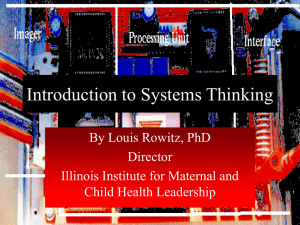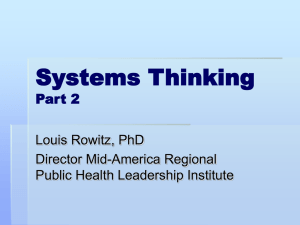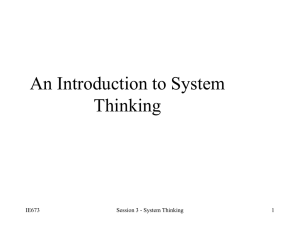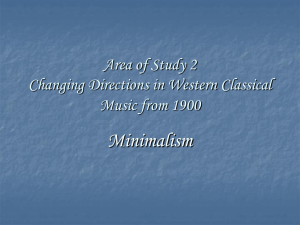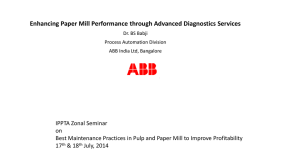View PowerPoint™ Slides
advertisement
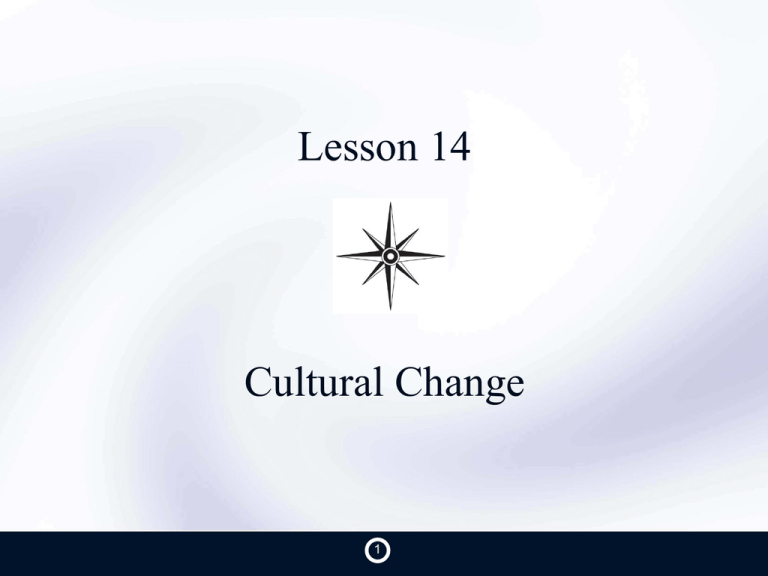
Lesson 14 Cultural Change 1 Purpose • To provide a framework for understanding and changing a culture • To understand systems thinking, which provides this framework 2 The Widget Department Same Job Same Place New Project New Project Team Project Fails Reject Project and Team Involvement Fear of Failure/Loss of Position Generalize Project and Team as a Waste of Resources Focus on Team Flaws and Project Challenges 2 How would you change the Widget Department? 4 Systems Thinking 5 Systems Thinking • All things are interconnected • They are interconnected by systems 6 What is a system? • A system is a collection of parts which interact with each other to function as a whole. 7 Building Blocks • All systems are comprised of two building blocks: • Reinforcing Loops – Change and growth • Balancing Loops – Stability, resistance, limits 8 Reinforcing Loops Small Changes eventually result in exponential growth. 9 A Penny A Day On the first day of the month, I give you a penny. On the second day, I give you two pennies. On the third day, four pennies. Day four, eight pennies. Day five, sixteen pennies. How many pennies do you have on day 15? How many on day 30? 10 Pennies Received Each Day Day Pennies Day Pennies 1 1 16 32,768 2 2 17 65,536 3 4 18 131,072 4 8 19 262,144 5 12 20 524,288 6 32 21 1,048,576 7 64 22 2,097,152 8 128 23 4,194,304 9 256 24 8,388,608 10 512 25 16,777,216 11 1,024 26 33,554,432 12 2,048 27 67,108,864 13 4,096 28 134,217,728 14 8,192 29 268,435,456 15 16,384 30 536,870,912 11 Lilies in a Pond There are 1,000,000 lilies in the pond. One-half of the lilies die each day. How many lilies are there on day 10? How long until there are none remaining? 12 Lilies Remaining Each Day Day 1 1,000,000 2 500,000 3 250,000 4 125,000 5 62,500 6 31,250 7 15,625 8 7,813 9 3,906 10 1,953 11 977 12 488 13 244 14 122 15 61 16 31 17 15 18 8 19 4 20 2 21 1 13 Reinforcing Loop Condition Growing Action or Contracting Action The condition will change – either growing or contracting 14 Balancing Loops Attempts to change the current condition are countered, returning you back to the beginning. The larger the attempted change, the more severe the counter measure. 15 Driving a Car Speed Pressure on Gas Pedal 16 Target: 55 miles per hour Balancing Loop Condition Target: 55 miles per hour Corrects Corrective Action 17 Interconnected Systems • Very often individual systems interconnect to form larger more complex systems. 18 Is a Culture a System? • A culture is an interconnected balancing system. • It is characterized by many balancing loops. • It is stable even though the environment is changing. 19 Cultural Change • If cultures are stable – how do we change them? 20 Cultural Change Current Reality Vision Existing Culture New Culture Tension Action Steps – Create reinforcing loops toward desired culture. – Eliminate balancing loops that maintain current culture. 21 Widget Department Possible Action Steps • Actions with reinforcing loops: – Explain benefits of job rotation – Offer a financial incentive – Provide adequate training • Actions which eliminate balancing loops: – Let those with the greatest concern be the last to convert – Offer job protection for an extended period – Provide specialized training to better help those with the greatest concerns. 22 Traditional Approach to Cultural Change 23 Implications for Leaders • Assess the existing culture. • If inadequate, create a shared vision of the desired culture. • Understand the current reality of the existing culture. • Take action: – visualize a new culture – understand the current status – take action by adding reinforcing loops, – or eliminating balancing loops. • Once the desired culture is achieved, be vigilant in maintaining its status. 24 Summary • Systems thinking provides a framework for understanding cultures • Cultures are balancing systems • This is good if we like what we have • If we don’t we can – – – – – Visualize a new culture Understand the current status Take action by adding reinforcing loops, Or eliminating balancing loops 25 This lesson is a modified excerpt from the book, Compass – Creating Exceptional Organizations: A Leader’s Guide, written by William F. Brandt, Jr., cofounder and former CEO of American Woodmark Corporation – the third largest producer of kitchen cabinets in America. Copyright 2013 William F. Brandt, Jr. This lesson may be copied, presented and/or distributed to up to five people. Distribution beyond five is subject to a user fee as described in the website: CompassCEO.com The book and related materials are also available from the website: CompassCEO.com 26
